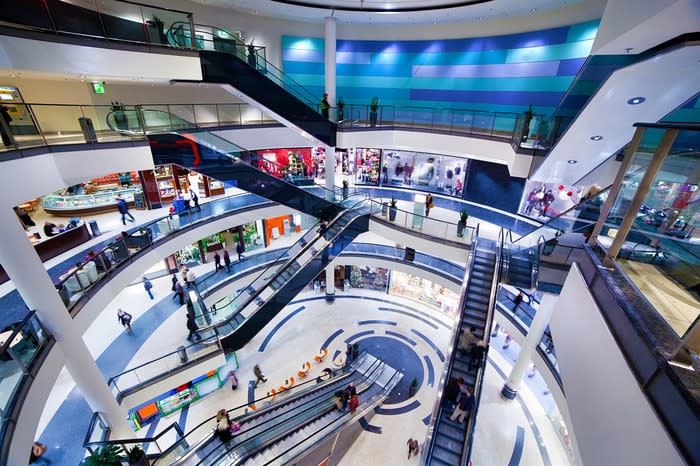Can CBL Recover From the Retail Apocalypse?
The "retail apocalypse" is a phenomenon whereby thousands of brick-and-mortar retail stores have closed and many national retail chains have gone bankrupt. The cause: a deadly cocktail of debt and declining sales due to competition from e-commerce. It has continued with a vengeance in 2019.
The hardest-hit segment of retail has been the American mall. Mall operator CBL & Associates Properties (NYSE: CBL) has acutely felt this pain, and its stock price reflects this. The stock is down over 90% from its highs a few years ago due to fears that CBL will not be able to survive the current onslaught.
Are these fears well founded?
How CBL has been affected by the retail apocalypse
CBL is a real estate investment trust (REIT) that owns shopping malls and leases out space to retail tenants. The company's focus has been regional malls, those that serve as the primary shopping center in a small city or town.
The company doesn't operate in Los Angeles or Miami, where luxury shopping malls still generate healthy traffic and sales. It operates in markets like Chattanooga, Tennessee, and Laredo, Texas, where the surrounding population is not growing as rapidly and has less disposable income.
A shopping center is only as strong as its tenants, and CBL has had exposure to many of the large department stores and apparel chains that have been hit the hardest. In 2013, the company reported that it had exposure to 63 Sears stores, 43 Macy's stores, and 69 JCPenney stores, among others. Not only have these department stores had to close many of their locations, but they were particularly quick to do so in regional malls managed by CBL, due to their relatively unfavorable demographics and sales per square foot.
CBL saw its tenant occupancy rate decline as stores closed faster than the company could release the space. Because shoppers do not want to visit a partially vacant mall, CBL has been under pressure to quickly find new tenants, which has led it to lower rental rates, putting pressure on mall profitability.
Additionally, CBL has had to invest in redeveloping vacant anchor spaces into new retail boxes for new tenants. For example, it has transformed former Sears stores into movie theaters, gyms, and grocery stores. But these transformations haven't come cheap. The company projected it would spend $11 million to redevelop just one JCPenney into three spaces for an H&M, an Outback Steakhouse, and a Planet Fitness.

Image source: Getty Images.
CBL's balance sheet
The retail downturn has left CBL strapped for cash as it loses tenants and must pony up more cash to redevelop its malls. The company has had to borrow money to execute on its turnaround, which has also put pressure on its balance sheet.
According to the company's most recent financial report, in Q2 2019, it has $4.4 billion in total debt. Its 2018 EBITDA was $626 million, which implies a leverage ratio (debt to EBITDA) of greater than seven times. That level of leverage is questionable business practice in most investment circles, and it is leading many investors to wonder if CBL will be able to pay back its debts.
To help alleviate its debt, CBL has been selling assets. So far in 2019, the company has sold $120 million in real estate, including a community center, an office building, and a hotel. Last year, the company sold $100 million worth of assets. These efforts are good to note, but selling a couple hundred million worth of real estate won't wipe out the $4.4 billion debt burden anytime soon.
Recent financial performance is still negative
Hopefully, the worst of the retail apocalypse is in the rearview mirror, but even if that is true, CBL is still showing deteriorating financial performance.
In the company's Q2 2019 financial report, it noted the following:
Portfolio same-center net operating income declined 5.7% year over year.
Portfolio occupancy declined 0.9% year over year.
Gross rent per square foot at stabilized malls declined 3.8% year over year.
Sales per square foot at stabilized malls increased 0.8% year over year.
Of this barrage of data, the only positive point was an increase in sales per square foot. Despite this increase, the company saw a decline in the rents it charged, a decline in occupancy, and a decline in its profitability.
Will CBL be able to turn around?
The retail apocalypse hasn't been kind to this cash-strapped mall operator. To make matters worse, 2019 has seen even more store closures and bankruptcies. CBL's financial figures are still not moving in the right direction, which puts into question the viability of the company's turnaround.
The negative financial trends are compounded by the company's stretched balance sheet position. It is certainly possible for CBL to turn around, but that is clearly not a safe bet to make today.
More From The Motley Fool
Luis Sanchez has no position in any of the stocks mentioned. The Motley Fool owns shares of and recommends Planet Fitness. The Motley Fool has a disclosure policy.
This article was originally published on Fool.com

 Yahoo Finance
Yahoo Finance 